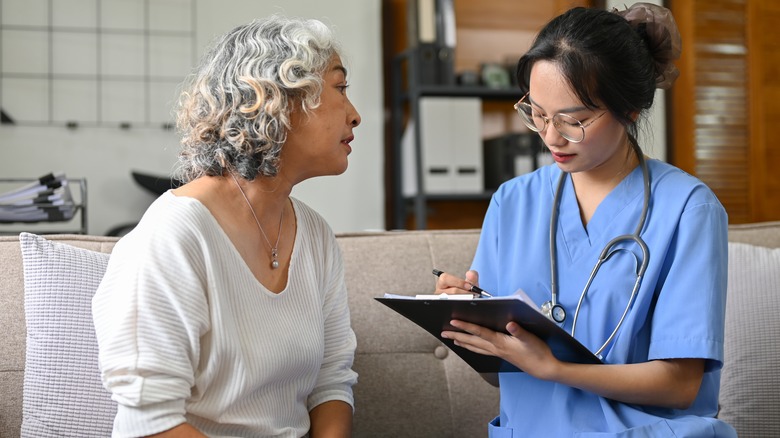How Often Do You Really Need To Get A Pap Smear?
If you're not sure how often you truly need to get a Pap smear, you're not alone. The major guidelines changed just over 10 years ago, and then again in 2022. It can take years to fully educate the public with updated medical directives, leaving many feeling a bit confused.
After the pap smear was discovered in 1945 to detect cervical cancer, the mortality rate for the disease plummeted by 70%. For decades afterward, doctors recommended an annual Pap test. But as the science evolved, researchers understood that cervical cancer takes several years to develop and that annual tests were ineffective and ultimately unnecessary.
Discussing a Pap test is incomplete without mentioning HPV, the human papillomavirus. In most cases, HPV doesn't cause cancer, but a high-risk version can. Now doctors recommend that women aged 21 to 29 take a Pap test alone every three years, according to The American College of Obstetricians and Gynecologists. Although women 25 to 29 can start taking the HPV test alone, doctors prefer the Pap test instead. Every five years, women aged 30 to 65 can take a Pap test and an HPV test. Or they can take only a Pap test every three years. Option three: get the HPV test alone every five years or co-test with both. According to the CDC, 10% of women infected by HPV are at higher risk for cervical cancer. The bottom line: It's good preventive healthcare to co-test with Pap and HPV every five years after age 30.
Are there any exceptions?
Yes. Generally, women over 65 can stop testing if they've never had cervical cancer or abnormal cells and if the previous two to three consecutive screenings were negative. However, there is some current research that says cervical cancer screenings are still pivotal for women over 65.
For younger women, you should increase how often you get a Pap smear under certain conditions. If you have a compromised immune system, are HIV positive, had cervical cancer in the past, or were exposed to DES, a hormone administered to pregnant women between 1940 and 1971, before birth, you should have screenings more often. Women who've had hysterectomies, which include the removal of the cervix, don't need the screening unless the hysterectomy was performed because of cervical cancer. Check with your doctor to be sure of what's right for you.
Here's an important reminder: Cervical cancer is preventable, and The National Cancer Institute is concerned about a big drop in screenings. Though they're not clear why it's happening, what they heard most often in a recent study was that women didn't know they needed the screening. The women least likely to get tested were Asian, Hispanic, members of the LGBTQ+ community, and those who lacked health insurance and/or lived in rural areas.
What happens during an exam?
You might feel a bit vulnerable during the test, but as far as screenings go, it's fast and it doesn't hurt. Both the Pap smear and the HPV test are given the exact same way. The doctor uses a speculum to get access to the cervix, which is at the bottom of your uterus and top end of the vagina, then uses a soft brush to gather cells to be tested.
You'll feel pressure, not pain, and the speculum might feel cold if it's steel. If you want, you can take one aspirin or a different pain reliever an hour before your appointment for a sense of comfort. By the way, don't be embarrassed to ask for a smaller speculum if you happen to still be a virgin.
Before you book a cervical screening, expect to abstain from sexual intercourse two or three days ahead of the test, and refrain from using creams, deodorant, and other products that may interfere chemically with the testing process. The American College of Obstetricians and Gynecologists reminds women that even though Pap tests aren't yearly, your OB-Gyn visit should be.


